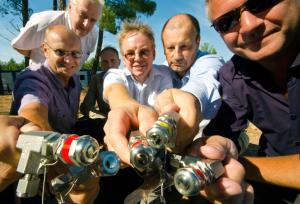Vacuum team cheers US delivery of "spearhead"
8 Oct 2012
-
Robert Arnoux
Having received the "spearhead" of the vacuum auxillary systems, the Vacuum team is now waiting for the next batch of test equipment (40 m³) ... and looking for a place to store it.
The components that were delivered on Wednesday, 20 September to Cadarache may look quite insignificant; their mass and their value represented no more than 0.001 percent of the Procurement Arrangement to which they belonged, but they carried a strong symbolic value.
The five pressure relief valves received by the ITER vacuum team are the very first components delivered by the US ITER Domestic Agency. They are part of the vacuum auxillary systems supply used in the acceptance and construction testing of many ITER procurements.
"What we have here," says ITER Vacuum Section Head Robert Pearce "is just the spearhead. It arrived on schedule and we are now waiting for the next batch of test equipment which consists of some 40 m3 of leak detectors, pumps, instruments etc., that we defined in collaboration with our US colleagues."
From acceptance to final commissioning, no less than 94 man-years of vacuum testing will be performed on the ITER components during the construction phase. Holding one of the five pressure relief valves in his hand, Liam Worth (vacuum team member responsible for the test program) states, "Over the next 10 years, this piece will have been used as part of more than 1,000 tests..."
The five pieces are quite simple—no spectacular technological achievement was involved in their manufacturing. However, they demonstrate that the complex and demanding procurement process established within the ITER Project has delivered: the first design review was held in November 2010, the Procurement Arrangement was signed in March 2011 and the "spearhead" was delivered as expected in September 2012.
The US and ITER Organization vacuum teams have kept to schedule; the vacuum team is now looking for a place to store the bulk of equipment that will soon be delivered to ITER. "A nice problem to be faced with ..." says Robert.


